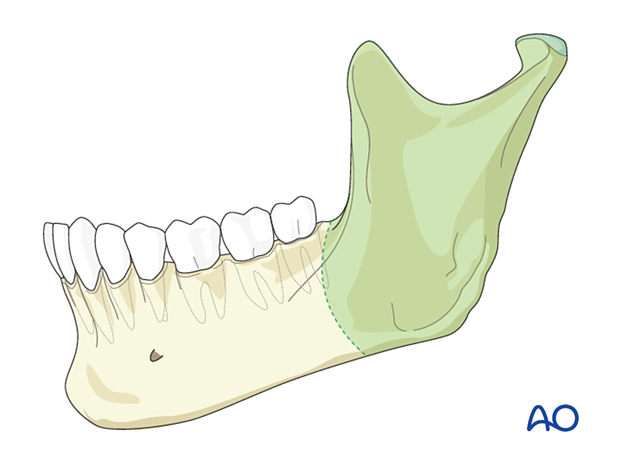Facelift (rhytidectomy) approach
1. Principles
Introduction
The facelift approach provides the same exposure as the retromandibular and preauricular accesses combined. The only difference is that the skin incision is placed in a more cosmetically acceptable location.
It exposes the entire ramus from behind the posterior border. Therefore, it may be useful for procedures involving the area on or near the condylar neck/head or the ramus itself. When using the facelift approach, the distance from the skin incision to the intervention area is reduced, allowing for a more direct approach to the ramus and condyle compared to that of the submandibular approach.

Anatomical structures
The anatomic structures to take into account are the trunk and branches of the facial nerve, the retromandibular vein, the greater auricular nerve, and the superficial temporal artery and vein.

Exposure
The exposure offered by the facelift incision (rhytidectomy) is indicated in green.

2. Skin incision
Use of local anesthetic and vasoconstrictors
The use of a solution containing vasoconstrictors ensures hemostasis at the surgical site. The two options currently available are local anesthetic or a physiologic solution with a vasoconstrictor alone.
The use of a local anesthetic with a vasoconstrictor may impair the facial nerve's function and impede the use of a nerve stimulator during the surgical procedure. Therefore, consideration should be given to using a physiological solution with a vasoconstrictor alone or injecting the local anesthetic with a vasoconstrictor very superficially.
Muscle relaxants used in general anaesthesia can also impair nerve function and must be avoided.
Incision
A standard facelift incision is made through the skin and subcutaneous tissues. This incision may vary depending on local anatomy and hair distribution patterns.
Part of the preauricular incision may be hidden behind the tragus (endaural incision).

3. Subcutaneous dissection of skin flap
A skin flap is elevated in the subcutaneous plane, taking care not to injure the great auricular nerve, lying below the subcutaneous tissues overlying the sternocleidomastoid muscle.
The flap must be widely undermined anteriorly and inferiorly.

The flap is undermined above the superficial musculoaponeurotic system (SMAS) level to identify the posterior border of the platysma and the nearby greater auricular nerve.

4. Dissection
Incision through SMAS
A vertical incision is made through the superficial musculoaponeurotic system (SMAS) onto the parotid gland, extending from just below the ear lobe towards the gonial angle.

Blunt dissection of the parotid gland
Bluntly dissect the parotid gland from the underlying masseter muscle. The dissection should be anterior to the retromandibular vein. Branches of the facial nerve may be exposed during the dissection. They should be identified and protected. Once the mandible's posterior border has been reached, an incision is made through the pterygomasseteric sling.

Subperiosteal dissection of the mandibular ramus
A periosteal elevator is used to strip the masseter muscle from the ramus. Further dissection superiorly along the posterior border exposes the condylar process.

5. Exposure
The illustration shows the amount of exposure obtained using this approach.

The illustration shows the amount of exposure one can obtain using this approach.

6. Wound closure
For wound closure, the pterygomasseteric sling is reapproximated with sutures.
The wound is reapproximated in layers for anatomic realignment and closure of dead space. The SMAS is resuspended. Any violation of the parotid gland capsule must be closed tightly to prevent a sialocele or a salivary fistula.

A small drain placed into the subcutaneous space may be necessary to prevent hematoma. The skin and subcutaneous tissues are then closed according to the surgeon's preference.












